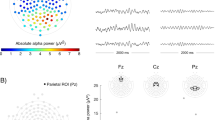Abstract.
An atypical EEG pattern of frontal brain activation, which has been related to compromised emotional regulation in children and adults, is hypothesized to be also present in children with externalizing behavior problems. Seventy-eight children at 11 years of age were examined to answer the following questions: 1) do children with externalizing behaviors exhibit an atypical pattern of frontal brain activation which can be linked to the severity of their problem behaviors? and 2) are there gender differences in these frontal activation patterns? Spontaneous EEG activity was subjected to power spectral analysis. In externalizing girls, the well-known pattern of a significantly greater right than left frontal brain activation emerged that has been found previously in emotionally disordered children, whereas healthy girls showed a significantly greater left than right frontal activation. In contrast, healthy boys demonstrated a significantly greater right than left frontal activation, whereas externalizing boys did not display a frontal brain asymmetry. Thus, the pattern of frontal brain activation was gender specific. The atypical activation pattern in externalizing children is hypothesized to be a biological correlate of difficulties in regulating emotion.
Similar content being viewed by others
Author information
Authors and Affiliations
Additional information
Accepted: 18 November 2002
Correspondence to Lioba Baving, M. D., Ph. D.
Rights and permissions
About this article
Cite this article
Baving, L., Laucht, M. & Schmidt, M. Frontal EEG correlates of externalizing spectrum behaviors. European Child & Adolescent Psychiatry 12, 36–42 (2003). https://doi.org/10.1007/s00787-003-0307-5
Issue Date:
DOI: https://doi.org/10.1007/s00787-003-0307-5




